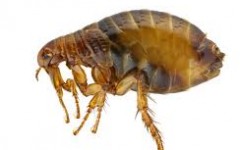About Fleas
 Fleas are common in all areas of the country except those that are extremely dry. They expand their populations during the warm, humid weather of spring and summer, while declining in numbers during the cool or dry weather of winter. These pests can feed on a number of hosts, which include dogs, cats, rodents, and humans. Humans are not preferred, but if the population of fleas becomes excessive or if they lose their host they will use humans to feed. Adults typically spend a majority of their time on the host animal, and not carpet. For this reason, pets are required to be washed thoroughly for effective control of fleas.
Fleas are common in all areas of the country except those that are extremely dry. They expand their populations during the warm, humid weather of spring and summer, while declining in numbers during the cool or dry weather of winter. These pests can feed on a number of hosts, which include dogs, cats, rodents, and humans. Humans are not preferred, but if the population of fleas becomes excessive or if they lose their host they will use humans to feed. Adults typically spend a majority of their time on the host animal, and not carpet. For this reason, pets are required to be washed thoroughly for effective control of fleas.
Flea Prevention
Preventive measures can be taken in an attempt to prevent flea infestations, although the possibility of one will always remain. Once a home owner has identified fleas in their home, the following steps should be taken before a flea treatment is administered by a professional:
- Clean all pet bedding thoroughly. This requires washing in hot water to kill all insects living in it.
- Remove pet food and water from the home. Fish tanks should be covered up, with their aerators disconnected.
- Toys and clothing on the ground should be picked up. This will allow the area to be accessible for treatment.
- Vacuum the entire household. This will remove much of the eggs and larvae developing in the home. It will also stimulate the pre-adults to emerge from their protected cacoons, thereby introducing them to the insecticide. Once finished, the vacuum bag should be sealed and discarded to an outside dumpster.
Treatments are administered twice to eliminate fleas. The developing insects living in cacoons are protected from the initial treatment. For this reason a second treatment is applied a week after the first. At this time all the developing insects are out of their cacoon, while also being too young to lay eggs of their own.

